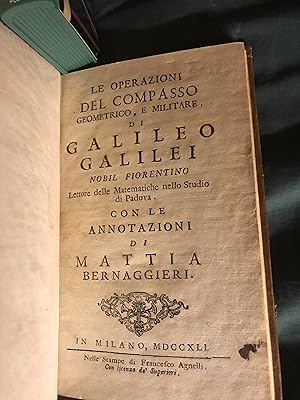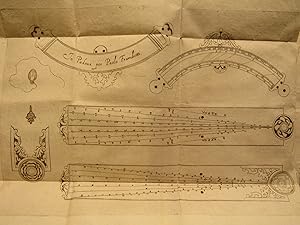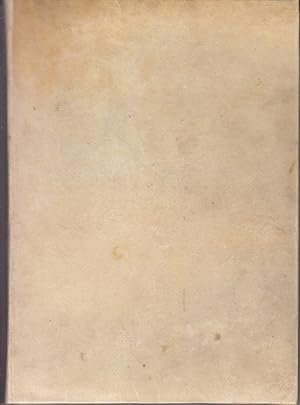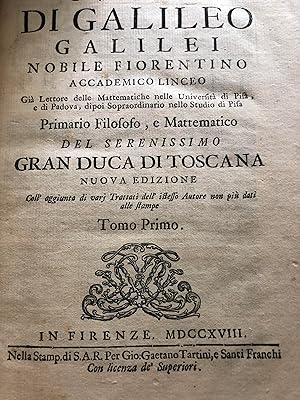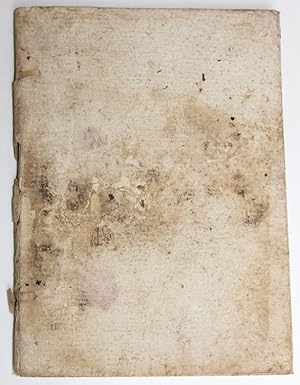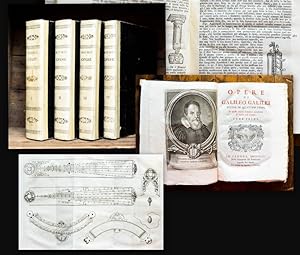galileo (Más de 1.400 resultados)
Tipo de artículo
- Todo tipo de artículos
- Libros (1.408)
- Revistas y publicaciones (8)
- Cómics (1)
- Partituras
- Arte, grabados y pósters (7)
- Fotografías
- Mapas
-
Manuscritos y
coleccionismo de papel (5)
Condición
Encuadernación
Más atributos
- Primera edición (107)
- Firmado (9)
- Sobrecubierta (63)
- Con imágenes del vendedor
- Sin impresión bajo demanda (956)
Gastos de envío gratis
Ubicación del vendedor
Valoración de los vendedores
-
Discorsi e dimostrazioni matematiche, intorno a due nuove scienze attenenti alla mecanica & i movimenti locali con una appendice del centro di gravità d'alcuni solidi.
Publicado por Leiden, Elzevier, 1638., 1638
Librería: Bernard Quaritch Ltd ABA ILAB, London, Reino Unido
Original o primera edición
First Edition. Small 4to, pp.[viii], '306' (recte 314), 6; woodcut device on title, numerous attractive woodcut illustrations and diagrams to text; marginal paperflaw to N4 and Z3, one or two marginal rust-spots, but a fine copy; elegantly bound in antique-style olive morocco, panelled in gilt; ownership inscription of Pierre Varignon (see below) to title, with his annotations, underlinings, and geometrical drawings on 11 pages; this copy from the Bibliotheca Mechanica, with booklabel to front pastedown.First edition of the first modern textbook of physics and the foundation of the science of mechanics; a very important copy, owned and annotated by Pierre Varignon, intimate friend of Newton, Leibniz, and the Bernoullis. Under permanent house arrest by decree of the Inquisition following the condemnation of his pro-Copernican Dialogo sopra i due massimi sistemi del mondo, in 1633 Galileo continued his unfinished work on mechanics. Once it was finished, the issue of ecclesiastical licence to print proved insurmountable in Italy, and Galileo resorted to the Elzeviers in Leiden. The Discorsi provide the mathematical foundation for the philosophical exposition of the Dialogo, thus being 'considered by most scientists as Galileo's greatest work' (Printing and the Mind of Man). 'The two sciences with which the book principally deals are the engineering science of strength of materials and the mathematical science of kinematics Galileo's Two New Sciences underlies modern physics not only because it contains the elements of the mathematical treatment of motion, but also because most of the problems that came rather quickly to be seen as problems amenable to physical experiment and mathematical analysis were gathered together in this book with suggestive discussions of their possible solution' (DSB V, p.245). Our copy is perhaps the most important to have come to the market in the last quarter-century. It belonged to Pierre Varignon (1654 1722), member of the Académie des Sciences and one of the preeminent scientists of his time, very close to Newton, Leibniz, and the Bernoullis. Varignon demonstrated the principle of the parallelogram of forces simultaneously with and independently of Newton. He was the first French scientist of note to advocate the new differential calculus. 'Varignon's interest in the volume was probably related to his work on De la Résistance des Solides in which he attempted to incorporate the hypotheses of both Galileo and Mariotte in a single formula. Todhunter and Pearson note, however, that in order to apply this formula it will usually be "necessary to assume some definite relation between the extension and resistance of the fibres"' (Roberts & Trent, Bibliotheca Mechanica, p.130). These are valid comments. However, more specifically, the annotations point to Varignon's keen interest in the sections devoted to defining uniform acceleration, and their corollaries. In this work Galileo acknowledges that at one time he thought it would be more useful to use the term 'uniform acceleration' for motion in which speed increased in proportion to the distance travelled, rather than to the time fit. Now he chooses to define uniform acceleration as the motion in which the change of speed is proportional to elapsed time. Varignon's economic underlinings and annotations home in on points of crucial interest, on the development of consequential theories from premises, on diagrams; they underscore points upon which Varignon raises doubts. His objections consist especially of displeasure with 'merae suppositiones', or 'gratis suppositiones', mere assumptions touching not so much the core of Galileo's theory as its corollaries. A full exploration of the geometric corollaries of Galileo's theory must indeed have been a crucial point of departure for the perfecting of Varignon's own theorem, in Projet d'une nouvelle mécanique, 1687, stating that if many concurrent forces are acting on a body, then the algebraic sum of torques of all the forces about a point in the plane of the forces is equal to the torque of their resultant about the same point. Carli and Favaro 162; Cinti 102; Dibner, Heralds 141; Grolier/Horblit 36; Norman 859; PMM 130; Riccardi I, 516.12/1; Roberts & Trent, Bibliotheca Mechanica, pp.129 30 (this copy); Sparrow, Milestones of Science 75; Wellcome 2648; Willems 2648. Language: Italian.
-
Dialogo Dove ne i congressi di quattro giornate si discorre sopra i due massimi sistemi del mondo Tolemaico, e Copernicano (dialogue)
Publicado por Giovanni Batista Landini, Florence, 1632
Librería: Magnum Opus Rare Books, Missoula, MT, Estados Unidos de America
Libro Original o primera edición
Hardcover. Condición: Fine. 1st Edition. First Edition, First Printing of GALILEO'S CELEBRATED DEFENSE OF THE COPERNICAN VIEW OF THE SOLAR SYSTEM. Eight years after Pope Paul V forbade Galileo to teach Copernican theory, Pope Urban VIII granted him permission to discuss Copernican astronomy in a book. Galileo's use of the formal dialogue allowed him to explore his Copernican theories fully within the rubric of the "equal and impartial discussion" required by Pope Urban VIII. The work "was designed both as an appeal to the great public and as an escape from silence. it is a masterly polemic for the new science. It displays all the great discoveries in the heavens which the ancients had ignored; it inveighs against the sterility, willfulness, and ignorance of those who defend their systems; it revels in the simplicity of Copernican thought and, above all, it teaches that the movement of the earth makes sense in philosophy, that is, in physics. The Dialogo, more than any other work, made the heliocentric system a commonplace" (PMM). Pope Urban VIII immediately convened a special commission to examine the book and make recommendations. In depicting the Pope as the simple-minded Aristotelian Simplicius, Galileo brought upon himself arrest, trial by the Inquisition and life imprisonment. The sentence was commuted to permanent house arrest, while the printing of any of his works was forbidden. A wonderful copy bound in early 18th-century Italian vellum. The binding is tight and the pages are clean with an early Italian hand signature on pastedown. This scarce First Edition has Woodcut diagrams lacking etched frontispiece and final blank. A wonderful copy of this 1632 First Edition seldom seen in this beautiful condition.
-
Galilei, Galileo (1564-1642). Istoria e Dimostrazioni intorno alle Macchie Solari e loro accidenti, comprese in tre lettere scritte all illustrissimo signor Marco Velseri Linceo. Rome, Giacomo Mascardi, 1613.
Publicado por Rome, Giacomo Mascardi, 1613., 1613
Librería: PrPh Books, New York, NY, Estados Unidos de America
Miembro de asociación: ILAB
Hardcover. Condición: Very Good. 4° (245x175 mm]. Collation: A6, B-S4, T6, V4. [4], 164 pages. The leaf A2 paginated as page 4. Roman and italic type. Woodcut device of the Accademia dei Lincei on the title-page. Galileo s engraved portrait on fol. A5r. Thirty- eight separate copperplates showing sunspots; five full-page engravings of Jovian satellites (unnumbered as pages and unsigned, but counted within the foliation and pagination); woodcut diagrams in text. Woodcut initials. Contemporary boards alla rustica . Spine with author s name inked horizontally on two lines. In a modern clamshell box. A large, untrimmed copy. Some foxing on the upper part of the title-page, light uniform browning throughout, more prominent to quire R. Light brown spots on some leaves, a paper flaw in the second of the five plates depicting the Satellites of Jupiter. Some contemporary underlining and vertical strokes in brown ink. Provenance: on the title-page the early inked note FL or FTL , presumably referring to the first owner of the copy; the bookseller Angelo Delai from Brescia (1842-1911; his stamp on the front flyleaf). A fine, wide-margined copy of the first edition, in the issue without Scheiner s letters (no priority), of this work first announcing Galileo s adherence to the Copernican system. In 1611, the German Jesuit and astronomer Christoph Scheiner (1573- 1650) sent three letters to Marcus Welser announcing his discovery of sunspots. Welser himself published these letters in Augsburg in 1612, under the title Tres epistolae de maculis solaribus; the work was illustrated by engraver Alexander Mayr (ca. 1559 - ca. 1616), while the author s identity remained disguised as Apelles . It circulated widely, reaching Galileo himself, as well as the circle of the Accademia dei Lincei, the Roman scientific academy patronized by Federico Cesi (1585-1630), provoking a certain amount of irritation. Indeed, the Florentine scientist had begun observing sunspots in 1610, and had already represented them thanks to a sophisticated system of telescopic drawings. Prompted by Cesi, Galileo decided to reply, publishing his Istoria e Dimostrazione intorno alle Macchie Solari both to claim the priority of his discovery and to contrast Scheiner s interpretations. The German Jesuit had, in fact, refused to admit any element of corruptibility on account of the heavens, and consequently had attributed these alleged imperfections to the effects of stellar shadows; meanwhile, Galileo convincingly argued that sunspots are nothing more than vapours issued by the sun itself owing to the extreme pressure of the heat. The Lincei Academy decided the book would be supplemented with illustrations befitting to both the wonder of Galileo s discoveries and the accuracy of his drawings, with Cesi writing to the Florentine scientist on 8 September 1612: it is now the turn of your adversaries to be vanquished by this sense experience because, arguing with it, they abuse reason (Galilei, Opere, vol. xi, p. 393; transl. in A. van Helden, Galileo and Scheiner on Sunspots , p. 378). The Academy paid no mind to expenses, and the skilled artist Mattheus Greuter (1564-1638) was entrusted with the challenging task of proffering the pictorial evidence. Cesi himself supervised the enterprise, constantly informing Galileo on its progress. Greuter created thirty-eight separate copperplates depicting sunspots, with each etching measuring 12.5 cm in diameter and closely matching Galileo s drawings, now held at the Vatican Library. The artist employed an elaborate technique, combining intaglio finissimo, geometric precision, and the use of special inks. The visual effect is extraordinary: Greuter s spots ghost across the paper s surface, adumbrating the sunspots analogous transmutations disappearing, reappearing, metamorphosing (R. S. Noyes, Mattheus Greuter s Sunspots Etchings, p. 466). Two different issues of Galileo s Istoria e Dimostrazioni intorno alle Macchie Solari are known, published at the same [.].
-
Discorso al Serenissimo Don Cosimo II¿Intorno alle cose, che Stanno in su l¿acqua, o che in quella si muovono.
Publicado por Cosimo Giunti, Florence, 1612
Librería: Martayan Lan, New York, NY, Estados Unidos de America
Hardcover. Condición: Near Fine. (2) ff, 77 pp, (1), (1) f with printer¿s emblem. Bound with: [GALILEI, Galileo & CASTELLI, Benedetto]. Risposta alle Opposizioni del S. Lodovico delle Colombe, e del S. Vincenzo di Grazia. Florence, Cosimo Giunti, 1615. (1) ff, (2), 319 [ie 335] pp with numerous mispaginations, (5) including printer¿s emblem. Bound in contemporary limp vellum with MS title on spine, ¿Galileo Galilei Opera¿, internally very fresh, an excellent copy in all respects. A remarkable pairing of two Galileana bound together by a contemporary follower of the power struggle between Galileo and the Aristotelians. The second augmented edition of Galileo¿s classic on hydrostatics, published the same year within months of the first edition, represents his first published work in physics (Drake, p. 179). The Discorso is hailed by historians of science as having united for the first time two previously separate disciplines: statics and dynamics, resulting in a new science of mechanics, containing his first published statements on the concept of moment, an abstract concept of physical force which has been shown to have dominated his early physical thinking, and contains several first announcements concerning some of his great astronomical discoveries relating to sunspots, the triple form of Saturn, and the phases of Venus. The present 2nd edition contains significant additional text concerning this important concept. The Risposta, one of the scarcest of Galileo¿s works on the market, contains his lengthy and scathing replies to his critics only a year before his official castigation by the Catholic Church. Two years after the publication of the Sidereus Nuncius which assured his place in the history of science, and after displaying his telescopic discoveries in Rome, Galileo returned to Florence and devoted himself to the study of floating bodies, ¿the real, intrinsic and total cause why some bodies float and others sink.¿ In the Discorso, Galileo supports Archimedes and opposes Aristotle on the behavior of bodies in water, arguing that the reason some solids sink is the excess of their weight over the weight of water. Employing the concept of moment¿ ¿the force with which the mover moves and the floating body resists¿ ¿and the principle of virtual velocities, Galileo far surpasses the hydrostatic considerations of Archimedes: ¿The new method enables Galileo to unify statics and dynamics into a new science of mechanics which became the foundation of modern physics¿ (Rose, The Italian Renaissance of Mathematics, p. 287). As noted above, the second edition may be distinguished from the first by the additional material contained therein; notably, Galileo drew attention to these additions by printing them in Roman type rather than Italic. Among these additions are Galileo¿s first announcements of the Sun¿s rotation period, his announcements of sunspots, and his discovery of the ¿horns¿ of Saturn.
-
[Dialogo] Systema cosmicum . in quo quatuor dialogis, de duobus maximis mundi systematibus, ptolemaico & copernicano, utriusq; rationibus philosophicis ac naturalibus indefinite propositis, disseritur . Accessit appendix gemina, qua SS. Scripturæ dicta cum terræ mobilitate conciliantur
Publicado por David Hautt for Elzevir, [Leiden &] Strassburg, 1635
Librería: SOPHIA RARE BOOKS, Koebenhavn V, Dinamarca
Miembro de asociación: ILAB
Original o primera edición
First edition. FIRST LATIN EDITION OF THE DIALOGO . First Latin edition of the Dialogo, Galileo's celebrated defence of the Copernican view of the solar system, the most notorious banned book of the 17th century. Written in dialogue form, it "was designed both as an appeal to the great public and as an escape from silence . it is a masterly polemic for the new science. It displays all the great discoveries in the heavens which the ancients had ignored; it inveighs against the sterility, wilfulness, and ignorance of those who defend their systems; it revels in the simplicity of Copernican thought and, above all, it teaches that the movement of the earth makes sense in philosophy, that is, in physics . The Dialogo, more than any other work, made the heliocentric system a commonplace" (PMM). "The Dialogo, far more than any work, convinced men of the truth of the Copernican system" (Gingerich). Pope Urban VIII was not persuaded, however, and immediately convened a special commission to examine the book and make recommendations. In casting the Pope as the simple-minded Aristotelian Simplicius, Galileo brought upon himself arrest, trial by the Inquisition and life imprisonment. The sentence was commuted to permanent house arrest, while the printing of any of his works was forbidden. The Dialogo remained on the index until 1832. This Latin edition was translated at Galileo's request by Matthias Bernegger (1582-1640), an Austrian from Hallstatt, who had studied in Strassburg, where he settled in 1603. In his preface he explains how he came to translate it, how he had taught himself Italian, and how eventually the Elzeviers, at the urging of the Hebraist Marcus Zuerius Boxhorn and others, persuaded him to undertake the work and agreed to publish it. In addition to rendering the work accessible to a larger audience outside Italy, Bernegger's translation also includes tracts by Kepler and Foscarini on the compatibility of the Copernican and Christian universes. These tracts were not present in the first edition. In August 1597, Galileo wrote to Kepler expressing his sympathies for Copernicanism, having received a copy of the Mysterium cosmographicum (1596) from him. At this time Galileo's support for Copernicus was Earth-based: Galileo had devised a theory of the tides involving the combined rotational motions of the Earth around its axis and, after Copernicus, around the Sun. Everything changed early in 1610 when Galileo first turned a telescope to the skies. Not only was the moon revealed to be mountainous and the Milky Way to consist of separate stars, contrary to Aristotelian principles, but a host of new fixed stars and four satellites of Jupiter were promptly discovered. Galileo's account of these discoveries was published in the Sidereus nuncius (Venice, 1610). Galileo saw in the satellites of Jupiter a miniature planetary system in which, as in Copernican astronomy, it could no longer be held that all moving heavenly bodies revolved exclusively about the earth. Galileo first spoke out decisively in print for the Copernican hypothesis in his 1613 work on sunspots, Istoria e dimostrazioni intorno alle macchie solari. During its composition he had taken pains to determine the theological status of the idea of incorruptibility of the heavens, finding that this was regarded by churchmen as an Aristotelian rather than a Catholic dogma. But attacks against Galileo and his followers soon appeared in ecclesiastical quarters. These came to a head with a denunciation from the pulpit in Florence late in 1614. A year later Galileo went to Rome (against the advice of his friends and the Tuscan ambassador) to clear his own name and to prevent, if possible, the official suppression of the teaching of Copernicanism. In the first, he succeeded, but on the second he failed: Galileo was instructed on 26 February 1616 to abandon the holding or defending of that view. No action was taken against him, nor were any of his books suspended. Returning to Florence, Galileo took up less theologically controversial topics, culminating in the publication of Il Saggiatore in 1623. Just before it emerged from the press, Maffeo Barberini became pope as Urban VIII. Galileo journeyed to Rome in 1624 to pay his respects to Urban, and secured from him permission to discuss the Copernican system in a book, provided that the arguments for the Ptolemaic view were given an equal and impartial discussion. Urban refused to rescind the edict of 1616, although he remarked that had it been up to him, the edict would not have been adopted. "The Dialogue Concerning the Two Chief World Systems occupied Galileo for the next six years. It has the literary form of a discussion between a spokesman for Copernicus, one for Ptolemy and Aristotle, and an educated layman for whose support the other two strive. Galileo thus remains technically uncommitted except in a preface which ostensibly supports the anti-Copernican edict of 1616. The book will prove, he says, that the edict did not reflect any ignorance in Italy of the strength of pro-Copernican arguments. The contrary is the case; Galileo will add Copernican arguments of his own invention, and thus he will show that not ignorance of or antagonism to science, but concern for spiritual welfare alone, guided the Church in its decision. "The opening section of the Dialogue critically examines the Aristotelian cosmology. Only those things in it are rejected that would conflict with the motion of the earth and stability of the sun or that would sharply distinguish celestial from terrestrial material and motions. Thus the idea that the universe has a center, or that the earth is located in such a center, is rejected, as is the idea that the motion of heavy bodies is directed to the center of the universe rather than to that of the earth. On the other hand, the Aristotelian concept of celestial motions as naturally circular is not rejected; instead, Galileo argues that natural circular motions apply equally to terre.
-
Opere di Galileo Galilei . In questa nuoua editione insieme raccolte, e di varij trattati dell' istesso autore non piu stampati accresciute
Publicado por per gli heredi del Dozza, [1655]-, Bologna, 1656
Librería: Liber Antiquus Early Books & Manuscripts, Chevy Chase, MD, Estados Unidos de America
Ejemplar firmado
Hardcover. Condición: Fine. FIRST COLLECTED EDITION. Two volumes bound in matching contemporary vellum, lightly soiled. Internally, a fine, broad-margined set with the usual variable light paper toning associated with this edition and scattered light foxing. Minor faults as follows: a paper repair to the blank margin of one leaf and two short marginal tears, far from text in Vol. I, and another in Vol. II (in "Il Saggiatore"); light stains to margins of four lvs. (F2, Q2, T2 and V2) in the "Mechanica"; a few instances of light foxing; a few ink spots to one leaf; occ. minor blemishes. Complete with the requisite number of parts, half-titles and the one added plate. With an engraved frontispiece by Stefano della Bella and an engraved portrait of Galileo by Francesco Villamena. The text is illustrated with astronomical and mathematical woodcuts; those in the "Sidereus Nuncius" showing the moons of Jupiter discovered by Galileo and his iconic images of the moon as viewed through his telescope. The woodcuts in the "Istoria e Dimostrazioni intorno alle Macchie solari" illustrate Galileo's observations of sunspots on the sun's surface. A near-comprehensive collection of Galileo's works, a number of which are re-printed here for the first time. Only the "Dialogo", which was still on the "Index of Prohibited Books" at the time of publication, is not included. In addition to Galileo's own works in astronomy, mathematics, physics and mechanics, this collection includes important works by his scientific peers and opponents. Among the landmark works included are the following: Volume 1 I. The Mathematical and Geometrical Compass (1606) This was Galileo's first publication, describing his invention of the mathematical and geometrical compass. Among its applications were the conversions of currencies and the calculation of compounded interest. "Throughout the Renaissance, many attempts were made to develop a universal instrument that could be used to perform arithmetical calculation and geometric operations easily. This need was felt especially in the military field, where the technology of firearms called for increasingly precise mathematical knowledge. To satisfy these requisites, the first proportional compasses were developed in the second half of the sixteenth century, among them some singular instruments known as the "radio latino" and the "proteo militare". The geometric and military compass of Galileo belonged to this class of instruments. Invented in Padua in 1597, the instrument is also linked to Galileo's activity in the Accademia Delia, founded in Padua to provide mathematical instruction for young noblemen training for a military career. With the seven proportional lines traced on the legs of the compass and the four scales marked on the quadrant, it was possible to perform with the greatest of ease all sorts of arithmetical and geometric calculations, ranging from calculating interest to extracting square and cube roots, from drawing polygons to calculating areas and volumes, from measuring gauges to surveying a territory. Between 1598 and 1604, Galileo instructed several European sovereigns on the use of his compass, among them Prince John Frederick of Alsace, Archduke Ferdinand of Austria, the Landgrave Philippe of Hesse and the Duke of Mantua. "The success of the instrument encouraged Galileo to divulge his invention still further. In 1606 he published 60 copies of Le operazioni del compasso geometrico e militare, each of which he sold privately along with one of the instruments. The production of compasses, from which Galileo earned a substantial profit, was entrusted to an instrument-maker whom the scientist housed for some years in his own home. The publication of the treatise immediately aroused great interest, so intense as to provoke bitter arguments in the academic world over the authorship of the invention. Already in 1607 Baldassarre Capra, one of Galileo's pupils, tried to claim credit for the invention of the instrument among erudite circles by publishing a treatise in Latin on its operations. Other adversaries of Galileo claimed that the instrument had been invented first by the Dutch mathematician Michel Coignet. Many variations in the instrument were made and, with the addition of new proportional lines, its fields of application were later extended. Proportional lines were added for architectural drawing and proportional lines for perspective drawing. Numerous variations were developed throughout the seventeenth and eighteenth centuries, while during the course of the nineteenth, the proportional compass was gradually replaced by the dissemination of highly refined slide rules which survived in the technical studios of engineers, architects and geometers up until the very recent advent of the computer." II. The Discourse on Floating Bodies (1612) This is Galileo's first work in physics. In this discourse, he unified the previously separate disciplines of statics and dynamics resulted in a new science of mechanics. Galileo used the principle of virtual velocities (from Archimedes) to demonstrate the more important theorems of hydrostatics, deducing from it the equilibrium of fluid in a siphon, and proved against the Aristotelians that the floating of solid bodies in a liquid depends not upon their form, but upon their specific gravities relative to such liquid. The publication of this work resulted in a debate between Galileo and his academic opponents, Lodovico Delle Colombe and Vincenzo Di Gratia, whose works (and Galileo's replies) are also printed here. "Using the concept of moment and the principle of virtual velocities, Galileo extended the scope of the Archimedean work beyond purely hydrostatic considerations.The Book on Bodies in water drew attacks from four Aristotelian professors at Florence and Pisa.Galileo prepared answers to his critics, which he turned over to Castelli for publication in order to avoid personal involvement. Detailed replies to two of them.written principally by Galileo himself appeared anonym.
-
Risposta alle opposizioni del S. Lodovico delle Colombe, e des S. Vincenzio di Grazia, contro al trattato del Sig. Galileo Galilei, delle cose che stanno su l'acqua o che in quella si muovono . Nella quale si contengono molte considerazioni filosofiche remote dalle vulgate opinioni
Publicado por Cosimo Giunti, Florence, 1615
Librería: SOPHIA RARE BOOKS, Koebenhavn V, Dinamarca
Miembro de asociación: ILAB
Original o primera edición
First edition. THE BUOYANCY DISPUTE - GALILEO REPLIES TO HIS CRITICS. First edition, rare, from the Riccati library, of Galileo's principal text on the controversy over floating bodies. This work was written as a reply to two attacks by Delle Colombe (1565-1623) and Di Grazia on Galileo's 1612 treatise on floating bodies, Discorso . intorno alle cose che stanno ub su l'acqua, o in quella si muovono. Although Galileo drafted replies to these (as well as two other polemical attacks on his treatise), this was the only one to be published. Like several of his polemics of this period, it appeared under the name of a colleague, in this case his pupil and friend Castelli (1578-1643). "Shortly after his return to Florence, Galileo became involved in a controversy over floating bodies. In that controversy an important role was played by Colombe, who became the leader of a group of dissident professors and intriguing courtiers that resented Galileo's position at court. Maffeo Barberini-then a cardinal but later to become pope-took Galileo's side in the dispute. Turning again to physics, Galileo composed and published a book on the behavior of bodies placed in water, in support of Archimedes and against Aristotle, of which two editions appeared in 1612. Using the concept of moment and the principle of virtual velocities, Galileo extended the scope of the Archimedean work beyond purely hydrostatic considerations . The book on bodies in water drew attacks from four Aristotelian professors at Florence and Pisa, while a book strongly supporting Galileo's position appeared at Rome. Galileo prepared answers to his critics, which he turned over to Castelli for publication in order to avoid personal involvement. Detailed replies to two of them (Colombe and Grazia), written principally by Galileo himself, appeared anonymously in 1615, with a prefatory note by Castelli implying that he was the author and that Galileo would have been more severe" (DSB). In the present reply to his academic critics, Galileo both enlarged the scientific reasoning behind his position and presented a vigorous philosophical defence of that position. In the second reply to Grazia, Galileo states that he made use of two basic principles, "that equal weights moved with equal speed are of like power in their effects, and that greater heaviness of one body could be offset by greater speed of another" (Stillman Drake). This copy contains the rare two additional leaves (Y2) completing the errata and giving the registration and printer's device, not recorded by Cinti. Provenance: From the library of the Riccati family (bookplate on front paste-down), whose most prominent bibliophile members were Jacopo Francesco Riccati (1676-1754) and his son Vincenzo (1707-75), both mathematicians and physicists. "About the first week in August [1611] a memorable dispute arose between Galileo and some philosophers over the conditions governing the floating and sinking of bodies in water . Galileo, his friend Filippo Salviati, and two professors of the University of Pisa were discussing condensation when one of the professors, Vincenzio di Grazia, brought up the example of ice, which he considered to be simply condensed water. Galileo replied that ice should rather be regarded as rarefied water, since ice floats and must therefore be less dense than water. The professors contended that ice floated because of its broad flat shape, which made it impossible for the ice to cleave-downward through the water. Galileo pointed out that ice held forcibly under water and then released seemed to manage to cleave through it upward, even though then its own weight ought to help hold it down. When it was argued that a sword struck flat on water resists, while edgewise it cuts easily through water, Galileo explained the irrelevance of this observation. He granted that the speed of motion through water was indeed affected by shape, as Aristotle himself had said, but not the simple fact of rising or sinking through water, which was the point at issue. Water offered resistance not to division, but to speed of division, while spontaneous rising or sinking of solids in water was governed only by the Archimedean principle. This discussion did not convince the professors. "Three days later, Di Grazia told Galileo that he had met someone who said he could show Galileo by experiments that shape did play a role in floating and sinking in water; this was Colombe, who had not been present at the initial conversation. Galileo wrote out the conditions of the contest: Colombe was to show by experiment that a sphere of some material that sank in water would not sink if the same material were given some other shape. Canon Francesco Nori was to referee the experiments presented by both sides. Colombe added the stipulation that he would decide on the material and shapes to be used, the material to be of nearly the same density as water itself, and Filippo Arrighetti was made co-judge with Nori. "During the next few days Colombe exhibited to many people his experiments, made with lamina, spheres, and cylinders of ebony. Galileo perceived that the contest was going to become a verbal one in this way; the real issue concerned the rising or sinking of bodies placed in water, not the behavior of bodies placed on its surface and incompletely wetted. Presumably he had the support of the referees on this, because when the meeting at Nori's house was scheduled, Colombe failed to appear. Galileo then sent to Colombe a newly worded challenge, specifying that all the materials used were to be placed entirely in the water before each experiment with them. A date was set for the meeting, this time at Salviati's house in Florence (not at his villa, several miles distant from the city). "By this time gossip about the contest came to the attention of Cosimo de' Medici, who told Galileo not to engage in public disputes but rather to write out his arguments in a dignified form worthy of a court representative. When the s.
-
Opere .
Publicado por Bologna, 1655
Librería: Martayan Lan, New York, NY, Estados Unidos de America
Libro
Hardcover. Condición: Near Fine. 2 volumes. I: (14) ff., 48, 48 pp., (4) ff., 160 pp., (2) ff., 68, 127 pp., (2) ff., 264, 43 pp., including allegorical frontispiece signed Stefano della Bella, Villamoena portrait of Galileo, and folding engraved plate of military compass. II: (1) f., 60 pp., (8) ff., 104 pp., (2) ff., 105-156, 48 pp., (4) ff., 179, (1) pp., (1) ff., 53-106 pp., (1) f., 103-126 pp., (4) ff., 238 [i.e., 242] pp., (3) ff. Woodcut initials and diagrams. Bound in contemporary vellum, title written in ink on spine and on lower edges; usual mild discoloration and light foxing on scattered leaves; several quires browned as usual. Generally a fine, wide-margined and fresh copy. First collected edition of Galileo's works, appearing only a year after his death and of great interest for his 17th-century reception: this was the edition in which Newton and later eminent scientists read their Galileo. Included here are not only most of the seminal pieces written and published over a lifetime, including the Starry Messenger of 1610, the first work of modern observational astronomy, but additional publications and letters by both supporters and antagonists. Together in one work they offer a veritable panorama of scientific activity in Italy during the first half of the seventeenth century, and are critical for the history of the formation of Galileo's text. The Opera contains many unpublished or little-known items provided to the editors by Vincenzo Viviani, Galileo's friend and disciple. Among them are a number of Galileo's hitherto unpublished letters and experiments and the La Bilancetta, his first scientific work, written in 1586. Both the Dialogo and the letter to Christina di Lorena were censored and are, therefore, omitted. A contemporary hand noted on the final flyleaf of Vol. 2, "La lettura de discorsi legati insieme è interdetta" ("The reading of the discourses bound together is forbidden."). * Cinti 132; Riccardi I.518-19.
-
Opere di Galileo Galilei, linceo nobile fiorentino, in questa nuova edizione insieme raccolte, e di varij Trattati dell istesso autore non più stampate, accresciute.
Publicado por per gli heredi del Dozza, 1656
Librería: L'angolo del vecchietto, Firenze, FI, Italia
Libro Original o primera edición
Rilegato. Condición: molto buono. prima edizione. Il frontespizio ed il primo trattato compreso in questa edizione hanno la data del 1656, ma tutti gli altri opuscoli contenuti nei due volumi portano l'anno 1655. All inizio, un rame inciso da Stefanin della Bella, rappresentante Galileo che presenta il cannocchiale a tre giovani donne. La terza pagina non numerata reca uno scritto a carattere bibliografico dell abate Luigi Razzolini, che si riporta: Edizione stimatissima, e la prima che abbia in sé raccolte le opere dell immortal Galileo. Devesi alle cure di Carlo Manolessi, il quale dedicolla al Granduca Ferdinando II. È citata, come testo di lingua, dagli Accademici della Crusca. Il presente sceltissimo esemplare in carta soda e di larghi margini apparteneva al celebre Iuano di cui sono le armi sopra le coperte del libro [si legge l insegna: Mane Nobiscum Domine], e poscia passò al famoso Daniele Huezio, il di cui stemma [ex libris] sta nelle guardie di quest opera. Questo insigne Prelato fece donazione in vita della sua vasta biblioteca alla Casa Professa della Compagnia di Gesù di Parigi. L atto di donazione di essa viene riportato nel Tomo V pag 164 del libro Amoenitates Literariae, Francofurti et Lipsiae, apud Daniel Bartholomaei, 1726, vol 14 in 8° Firmato: Ab. Luigi Razzolini Nella stessa pagina, in alto, a lapis leggero, un'annotazione poco leggibile: Catalogo Molina (?) 1860, paoli 45. Nella quarta pagina, a penna, in alto Domus Profess Jesu. In basso è incollata una striscia di carte stampata, di evidente provenienza gesuitica: Ne extra hanc Bibliotecam efferatur. Ex obedientia . Rilegato con copertina rigida in cuoio. Una raccolta quasi completa delle opere di Galileo, alcune delle quali sono ristampate qui per la prima volta. Solo il "Dialogo", che era ancora nell'"Indice di Libri Proibiti" al momento della pubblicazione, non è incluso. Stato fisico: una foto mostra l'aspetto esteriore dei volumi: la secchezza delle copertine in pelle l'ha alquanto danneggiate. La copertina del primo volume è staccata. All acquisto (65 anni fa circa) era attaccata con due cordicelle che uscivano dalle nervature del dorso; poi, col tempo, queste hanno ceduto. Non abbiamo spazio sufficiente per l'adeguata descrizione del contenuto dei due volumi; tale documento, unitamente a qualche dettaglio sull' abate Razzolini e su Huetio, verrà inviato e chi ne farà richiesta.
-
1744 1ed COMPLETE Works of GALILEO Galilei Italian Astronomy Illustrated 4v SET
Publicado por Padova : nella stamp. del Seminario, appresso G. Manfre, 1744., 1744
Librería: Schilb Antiquarian, Columbia, MO, Estados Unidos de America
Libro Original o primera edición
Hardcover. Condición: Near Fine. 1st Edition. 1744 1ed COMPLETE Works of GALILEO Galilei Italian Astronomy Illustrated 4v SET first to include the Dialogo / RARE compare@$20,000+ Third collected edition of Galileo's works, the first complete, and the first to include the Dialogo, along with other material published here for the first time. This third edition, edited and annotated by Giuseppe Toaldo, includes for the first time, added as the fourth volume. Galileo Galilei (1564 1642), was an Italian astronomer, physicist, engineer, philosopher, and mathematician who played a major role in the scientific revolution during the Renaissance. Galileo has been called the "father of observational astronomy", the "father of modern physics", and the "father of science". We find this same incredible set for sale elsewhere for $19,300! Main author: Galileo Galilei; Giuseppe Toaldo Title: Opere di Galileo Galilei, divise in quattro tomi, in questa nuova edizione accresciute di molte cose inedite. Published: Padova : nella stamp. del Seminario, appresso G. Manfre, 1744. Language: Italian Notes & content: 1st edition with fourth volume o 3rd edition based on original 1656 edition 4 volume set, complete Beautiful vellum binding Engraved portrait frontispiece by Zucchi, volume I + folding engraving Engraved printer s device on other volumes COMPLETE with Signatures: v. 1: pi A-4S 4T²; v. 2: pi² A-4A 4B²; v. 3: pi² A-3O 3P² ('3P1' + 3P1); v. 4: a A-2V COMPLETE with Pagination: v. 1: [8], lxxxviii, [4], 601, [1] pages, [2] leaves of plates (1 folded); v. 2: [4], 564 pages, [1] leaf of plates (a table); v. 3: [4], 486 pages; v. 4: [8], 342, [2] pages. FREE SHIPPING WORLDWIDE Wear: wear as seen in photos Binding: tight and secure vellum binding Pages: collated and entirely complete with all pages Publisher: Padova : nella stamp. del Seminario, appresso G. Manfre, 1744. Size: ~10in X 7.25in (25.5cm x 18cm) FREE SHIPPING WORLDWIDE Shipping: Very Fast. Very Safe. Free Shipping Worldwide. Satisfaction Guarantee: Customer satisfaction is our first priority. Notify us within 7 days of receiving your item and we will offer a full refund guarantee without reservation. $15,000 Photos available upon request.
-
Opere, divise in quattro tomi, in questa nuova edizione accresciute de molti cose inedite (The Works, divided into four volumes, in this new edition enhanced by many unpublished things).
Publicado por Gio. Manfrè, Padova, 1744
Librería: Athena Rare Books ABAA, Fairfield, CT, Estados Unidos de America
First Complete Collection. Volume I: 1 leaf with engraved portrait on verso + TP + [i]-[ii] = A Chi Legge (To The Reader) + [iii]-[vi] = Indice + i-xlv = Prefazione Iniversale + xlvi-lxxxviii = Vita del Galileo + [lxxxix]-[lxxxx] = Dedicato al Serenissimo Da Cosimo Medici + [lxxxxi]-[lxxxxii] = A I Discreti Lettori (To Discreet Readers) + 1-601 + [602] = Noi Riformatori (We Reformers); Volume II: TP + [i]-[ii] = Indice + 1-564; Volume III: TP + [i]-[ii] = Indice + 1-486; Volume IV: TP + [i] = A Chi Legge (To The Reader) + [ii] = Indice + [iii]-[vi] = Sententia Cardinalium in Galileum (Thoughts of the Cardinals regarding Galileo) + 1-342 + [343] = Noi Riformatori (We Reformers) + one folding plate. Quarto. First Complete Collection. (Cinti 176; Carli and Favaro 478; Houzeau and Lancaster 3386; Riccardi I/1 522 22 ("molto più completa ed ordinata delle due precedenti" i.e. "much more complete and orderly than the previous two [editions]).The First Complete Collected Edition of Galileo's WorksWith the engraved portrait frontispiece by Zucchi in Volume I along with engraved printer's device on titles, head- and tailpieces, numerous woodcut initials, engravings and figures in the text, and 2 plates (one folding).Although the third overall collected edition of Galileo's Works, this is the first complete collection - including for the first time his important and famous Dialogo sopra i due massimi sistemi (A Dialogue Concerning the Two Great World Systems - which was still listed on the Index Prohibitorum) along with other materials that appear here for the first time. The first edition of the Works was published in 1656 in Bologna in two volumes. This was then reprinted in 1718 in Florence with a new third volume. This third collected edition of The Works was published in 1744, edited and annotated by the astronomer Giuseppe Toaldo, who added a fourth volume which included - as already noted - for the first time Galileo's famous but prohibited Dialogo. In addition, newly added to this edition are the Trattato del modo di misurare con la vista (A treatise on the way of measuring by sight), Ventitrè lettere a diversi, delle quali sedici al Micanzio e tre al Gualdo (Twenty-three letters to several people, of which sixteen are to Micanzio and three are addressed to Gualdo) along with Problemi vari e pensieri vari (Various problems and various thoughts). Contemporary drab boards ("carta rustica") with later (but lovely) paper spine labels. All pages are uncut with wide margins. There is a gradually diminishing dampstain to the first ten leaves of Volume II, along with a tiny worm track across one line of the final leaf of Volume III. Overall, this is a truly gorgeous set of Galileo's Works presented their original condition and preserved in two black morocco-backed clamshell boxes. ADDITIONAL PHOTOS AVAILABLE UPON REQUEST.
-
OPERE DI GALILEO GALILEI LINCEO NOBILE FIORENTINO GIA LETTORE DELLE MATEMATICHE NELLE VNIUERSITA DI PISA, E DI PADOUA, DI POI SOPRAORDINARIO NELLO STUDIO DI PISA. PRIMARIO FILOSOFO, E MATEMATICO DEL SERENISSIMO GRAN DUCA DI TOSCANA. In quest nuoua editione insieme raccolte, e di varij Trattati dell istesso Autore non più Stampati accresciute.
Publicado por Firenze Tartini & Franchi 1718, 1718
Librería: Buddenbrooks, Inc., Newburyport, MA, Estados Unidos de America
Original o primera edición
3 volumes. Rare first three volume collection, the second issuance of certain parts of the OPERE and the first printing of many of the works of Galileo or pieces heretofore unpublished in any form including the GIORNATA SESTA DEI DISCORSI E DIMOSTRAZIONI MATEMATICHE INTORNO ALLE NUOVE SCIENZE. With a very finely engraved vignette title-page printed in black and red to volume one, also an engraved portrait of Galileo, engraved folding plan, folding plate of the compass, many woodcut plates, astronomical renderings, mathematical tables and diagrams throughout, a number of fine woodcut initials. 4to, [241mm x 180 mm], handsomely bound in contemporary bindings of fine full mottled calf, handsomely decorated in gilt on the spines with gilt panels incorporating a floral motif between gilt-tooled raised bands, two compartments featuring fine gilt ruled and lettered red morocco labels. cxii, 628, 2 page errata; [viii], 722, errata; [vi], 484, [50pp of errata, index, registri, etc]. A truly fine copy, large and unusually fresh. A rare survival in contemporary state, crisp and an especially clean copy throughout, the bindings quite handsome with only minimal wear or evidence of age. EXTREMELY SCARCE IN FULL CALF BINDINGS OF THE PERIOD. USUALLY ENCOUNTERED IN VELLUM BINDINGS, THIS RARE EDITION OF GALILEO S COMPLETE WORKS (excepting the DIALOGO, which was still on the Index of Prohibited Books at the time), preserves a record of some of the most seminal discoveries in astronomy, scientific methodology, mathematics, primary work in the study of motion, as well as the most significant support of the Copernican theory of a heliocentric planetary system--in other words, the embodiment of the "Galilean Revolution." This issue of the OPERE, contains an entire volume of Galileo s writings which appear here for the first time, having never before been printed. The long list of these first printings is given by Riccardi (p. 520-521) and cited by Centi. Included are the GIORNATA SESTA DEI DISCORSI E DIMOSTRAZIONI.as well as other works such as the LETTERE IN PROPOSITO DI TROVARE LE LONGITUDINI, the NOTE SOPRA IL NUNZIO SIDEREO., the LA OPERAZIONI ASTRONOMICHE and a profusion of other works. Contained in this collection are many of the most important works in the history of science and physics, works that would cost many, many thousands of dollars to collect individually. Some among these are: RISPOSTA ALLE OPPOSITIONI , Galileo s work on virtual velocity; DISCORSO AL SERENISSIMO DON COSIMO II, on floating bodies and expanding greatly on the work of Archimedes; The DIFESA, his first work of Astronomy; LE OPERATIONI DEL COMPASSO GEOMETRICO, E MILITARE, the seminal work on the compass and it s use in scientific and military enterprise. In 1610 Galileo published his SIDEREUS NUNCIUS (included here), in which he described the construction of his telescope and his observations using the new instrument. His discoveries did not prove that Copernicus's heliocentric theory was correct, but they did show that geocentric philosophy of Aristotle and the geocentric system proposed by Ptolemy were incorrect, providing strong evidence for the heliocentric theory--an implausible theory which had largely been ignored for sixty years after Copernicus's death. His new support for the Copernican system reopened the controversy, and in 1615 he was officially silenced as regards the truth of astronomy. " Astronomy and the science of motion, rightly understood, says Galileo, are hand in glove. There is no need to fear that the earth's rotation will cause it to fly to pieces" (PMM). Galileo pioneered the study of motion and its mathematical analysis, a field which was taken up by Decartes and Huygens and culminated in the "massive achievements of Newton in dynamics and gravitational astronomy". "Galileo, more than any other man, had introduced the change in our manner of thinking that broke with ancient and led on to modern science. Contributions had also been made by Copernicus, by Vesalius, by Harvey, by Tycho, and by Kepler and others. The share of Galileo, however, is overwhelming.[It] was more than an addition to knowledge. It was more even than an alteration in the conception of the structure of the universe. It was rather a change in mood as to the kind of knowledge that was to be sought. It partook of the nature of a philosophical crisis" (Singer, A HISTORY OF SCIENTIFIC IDEAS, p. 249). The influence of the new mood affected ideas regarding the mechanical world, the extension of the senses, the idea of the universe as mathematical and boundless, and indeed altered the whole world of science and religion.Gamba 227; Centi 170; Riccardi I, 520-521; Carli-Favaro 431. Razzolini 157; Graesse III, 15.
-
Dialogo di Galileo Galilei Linceo Matematico Supremo ( ) Dove ne i congressi di quattro giornate si discorre sopra i due massimi Sistemi del Mondo Tolemaico, e Copernicano ( )
Publicado por Florence [i.e. Naples], Tartini e Franchi [Fiorenza; Firenze; Napoli], 1710
Librería: Orsi Libri ALAI, ILAB, Milan, Italia
Libro
Rilegato. Condición: ottimo. seconda edizione. "EPPUR SI MUOVE": A LOVELY COPY OF GALILEO'S CELEBRATED "DIALOGO" IN THE SECOND EDITION. GALILEI, Galileo. Dialogo di Galileo Galilei Linceo Matematico Supremo ( ) Dove ne i congressi di quattro giornate si discorre sopra i due massimi Sistemi del Mondo Tolemaico, e Copernicano ( ) Florence [i.e. Naples], Tartini e Franchi, 1710. 4to, 2 parts in 1 volume; ff. [6], pp. 458, ff. [15]; ff. [1], pp. 84; with numerous illustrations in the text. Both parts with individual t-p, being the first title printed in red and black. the second part opens with a letter to the Gran Duchess of Tuscany. Contemporary full stiff vellum, ms. title to spine. Sporadic marginal spotting, short tear along rear hinge at the head of the spine. All edges sprinkled in blue. Original endpapers. An excellent copy. Second Italian edition of "Dialogo sopra i due massimi Sistemi del Mondo", which first appeared in 1632 in Florence. The work "was designed both as an appeal to the great public and as an escape from silence. it is a masterly polemic for the new science. It displays all the great discoveries in the heavens which the ancients had ignored; it inveighs against the sterility, willfulness, and ignorance of those who defend their systems; it revels in the simplicity of Copernican thought and, above all, it teaches that the movement of the earth makes sense in philosophy, that is, in physics. The Dialogo, more than any other work, made the heliocentric system a commonplace" (PMM). This is Galilei's famous defense of Copernican heliocentrism, and the direct cause of his trial and imprisonment. In 1624, eight years after being forbidden to promulgate heliocentrism by the previous pope, Galileo was granted permission to write on the subject by the new Pope Urban VIII, his friend and patron for more than a decade on the condition that Aristotelian and Copernican theories were put forward equally and impartially. To this end, Galileo wrote his work as a dialogue between Salviati, a Copernican, and Simplicio ("Dummy"), an upholder of the geocentric Ptolemaic and Aristotelian orthodoxy. Carli-Favaro 413; Cinti 168; Riccardi, II, 512. PMM 128 (1st Ed.).
-
Quinto libro degli Elementi d'Euclide, ovvero Scienza universale delle proporzioni speigata colla dottrina del Galileo, con nuov' ordine distesa, e per la prima volta pubblicata . Aggiuntevi cose varie, e del Galileo, e del Torricelli; i ragguagli dell'ultime opoere loro, con altro, chedall' indicie si manifesta
Publicado por Condotta, Florence, 1674
Librería: SOPHIA RARE BOOKS, Koebenhavn V, Dinamarca
Miembro de asociación: ILAB
Original o primera edición Ejemplar firmado
First edition. SIGNED AND INSCRIBED BY VIVIANI TO MARIOTTE. The true first edition, very rare, signed and inscribed by Viviani to Edme Mariotte, of this important Galileanum, an assembly of previously unpublished writings by Galileo, together with texts by Torricelli and Viviani himself. Most importantly, it contains the first printing of a Galileo manuscript concerned with the Eudoxian theory of proportion which may be regarded as a supplement to the Discorsi (1638); the manuscript had been given to Viviani (1622-1703), Galileo's distinguished pupil, amainuensis, and biographer, by Cardinal de' Medici. Galileo had composed this manuscript in response to Viviani's demand that Galileo provide a more secure geometrical basis for his theory of falling bodies. As Galileo wrote to Benedetto Castelli in 1639, 'Objections made to me many months ago by this young man [Viviani] who is now my guest and disciple, against that principle postulated by me in my treatise on accelerated motion . made me think about this again in such a way as to persuade him that that principle might be conceded as true. Finally, to his and my great delight, I succeeded in finding a conclusive demonstration" (Boschiero, pp. 43-44). The manuscript had been dictated, in dialogue form, by Galileo to Torricelli in November 1641 (Galileo died on January 9, 1642). Since Torricelli's book on the theory of proportion (written in 1647) was not published, this edition by Viviani of Galileo's Fifth Day of the Discorsi (pp. 61-78) is the first printing of Galileo's reform of Book V of the Elements. It contains "Galileo's reflections on two definitions found in Euclid's Elements, that of 'same ratio' in Book V, and that of 'compound ratio' on Book VI. These were the two most important keys taken from antiquity in creating Galileo's mathematical physics . Galileo's critique of these definitions is by no means trivial. His discussion of Book V, Definition V, shows how a rigorous theory of irrational magnitudes can be built on the natural numbers by means of equimultiples . That is a large step in formulating a rigorous analysis of the continuum. His discussion of the spurious Book VI, Definition V illuminates the nature of mathematical definitions in general, essential to foundational analysis" (Drake, pp. 421-422). Galileo's treatise is prefaced by Viviani's own attempt to render more rigorous the theory of proportions, which includes ten new principles (pp. 1-60). The work also includes 12 letters from Galileo to an unnamed French scholar, an unpublished treatise by Galileo on the 'angle of contact', other unpublished works by Galileo on topics including the construction and use of telescopes and the movement of animals, and writings by Torricelli on Euclid, Book VI, and by Viviani on Euclid, Book I. A second edition was issued in 1676, with a second part containing the solution of 36 problems which had been published as challenges by a Leiden student in 1675, and with the dedication dated 16 May 1676, although the title page date remained 1674. The first edition is very rare: ABPC/RBH list only this copy since 1961. Institutional holdings are difficult to assess as collations are rarely given and the title page carries the same date in both editions. Provenance: Edme Mariotte, French physicist known for formulating Boyle's law independently - "honored as the man who introduced experimental physics into France, Mariotte played a central role in the work of the Paris Academy of Sciences from shortly after its formation in 1666 until his death in 1684" (DSB) (inscribed by Viviani on title verso 'A Monsieur Mariotte' and 'Vinc. Viviani' at bottom right); inscription of a Jesuit seminary on half-title recto, shelf-marks on front endpapers. "Viviani (1622-1703) was the son of Jacopo di Michelangelo Viviani, a member of the noble Franchi family, and Maria Alamanno del Nente. He studied the humanities with the Jesuits and mathematics with Settimi, a friend of Galileo's. His intelligence and ability led to his presentation in 1638 to Ferdinand II de' Medici, grand duke of Tuscany. Ferdinand introduced him to Galileo, who was so impressed by his talent that he took him into his house at Arcetri as a collaborator in 1639" (DSB). "Often described as 'Galileo's last student,' Viviani is a principal actor in the standard account of the reception of the Two New Sciences, included for his devotion to his late teacher and for the volume of textual material he preserved and produced . Viviani is often considered in tandem with another of Galileo's students, Evangelista Torricelli. Torricelli and Viviani served successively in Galileo's former position as mathematician to the Grand Duke of Tuscany . After Galileo's death, both Viviani and Torricelli continued to work with Galileo's unpublished manuscripts. They developed some of these writings into two additional 'days' to augment the 1638 publication. The Fifth Day was published in 1674 by Viviani as Quinto Libro degli Elementi d'Euclide ovvero Scienza Universale delle Proporzioni (Raphael, pp. 47-48). "During the last months of Galileo's life, as Viviani embarked on a career inside the Tuscan Court, they worked together in order to strengthen the role of mathematics in natural philosophy . The topic they worked on together to achieve this was the geometrical demonstration of accelerating falling bodies. Galileo's and Viviani's combined efforts to illustrate accelerated motion on inclined planes, resulting in the scholium Viviani added to the Third Day of Two New Sciences, became a major part of Viviani's education, shaping the natural philosophical skills, commitments, and agendas he was to use during his entire career . "To complete his dynamical analysis of the ratios of speeds of bodies falling down differently inclined planes, [Galileo] wrote the following postulate; a critical part of his mathematical demonstration of the physical phenomenon of accelerating falling bodies: the body always reaches the same sp.
-
Dialogo di Vincentio Galilei, nobile Fiorentino. Della musica antica, et della moderna
Publicado por In Fiorenza, appresso Giorgio Marescotti appresso Giorgio Marescotti, 1581
Librería: Delirium Books · Susana Bardón, Madrid, España
Original o primera edición
Encuadernación de tapa dura. Condición: Bien. 1ª Edición. Fol. (33,2 x 21 cm.) 2 h. inc. port. grabada en madera, 149 p., 5 h. sin num. de tabla, al vuelto de la última el colofón. Cabeceras, capitulares y grabados en texto, algunos a toda plana. Plena piel del XVIII, lomo desgastado, algo abierto por los cajos, hierros dorados, tejuelo parcialmente conservado. Primera edición de una de las obras más importantes en la historia de la música, en especial de la melodía y la ópera barrocas. Tiene la particularidad de ser el primer libro en contener el primer ejemplo de grabado musical. Vincenzo Galilei, padre de Galileo Galieli, fue un consumado compositor, laudista, cantante y compositor florentino, cuyo rechazo a la polifonía allanó el camino para la ópera. Fue de los primeros músicos en someter el sonido instrumental a la razón de la ciencia empírica. Se dice que fueron los experimentos de Galilei con el sonido el origen de la física experimental, lo que llevaría a su hijo a cuestionarse el mundo para verificar las leyes de la naturaleza como un hecho empírico. Vincenzo Galilei estableció las bases sobre las que se construiría la nueva música , relacionando las palabras y el sonido con el mundo emocional del oyente. Y, desde ese preciso instante, la Teoría de los Afectos dejó de ser solo teoría, convirtiéndose en un lenguaje que hace partícipe de sus efectos al espectador. Última hoja remarginada y con injerto en la mitad inferior. Pequeño desgarro en la esquina superior del fol. 115 sin afectar al texto. Adams G 139; Cinti 6; RISM B. IV, p. 344; Eitner IV, 128; Fetis III, p. 384.
-
Dialogo. Dove ne i congressi di quattro giornate si discorre sopra i due massimi Sistemi del Mondo Tolemaico e Copernicano. Proponendo indeterminatamente le ragioni Filosofiche e Naturali tanto per l'una quanto per l'altra parte. In questa seconda impressione. Accresciuto di una lettera dello stesso non più stampata e di varj Trattatti di più Autori i quali si veggono nel fine del Libro.
Publicado por Tartini e Franchi, Napoli, 1710
Librería: Libreria Antiquaria Giulio Cesare di Daniele Corradi, Roma, ROMA, Italia
p.perg. coeva con tass. Macchioline alla coperta Grande stemma in rame della Crusca al frontespizio, titolo in rosso e nero. Nella seconda parte contiene anche la Lettera del Foscarini sopra l'opinione de' Pitagorici, uno scritto sulla Perioche di Johannes Kepler, un estratto di Didacus à Stunica e la Sentenzia di condanna e l'abiurazione del Galilei. Cinti 168 Parenti 86 Gamba 476 Riccardi I 512 Raro. Wellcome III 83 Graesse III 15 Brunet II 1462. (12) + 458 + (30); (2) + 83 (ma 81) con molte xilografie n.t. p. 185x230 mm.
-
Opere di Galileo Galilei; Accademico linceo; nobile fiorentino, Gia Lettore delle Matematiche nelle Universita di Pisa, e di Padova, di poi Sopraordinario nello Studio di Pisa. Nuova edizione
Publicado por Tartini e Franchi, 1718
Librería: Sequitur Books, Boonsboro, MD, Estados Unidos de America
Miembro de asociación: IOBA
Libro
Hardcover. Condición: Good. 2nd. 3 volume set. Second edition of Galileo's collected works, edited by Tommaso Buonaventuri, who contributed a detailed preface. The first two volumes largely reproduce the material collected by Manolessi in the first edition (still without the two banned works). The third volume is devoted to previously unpublished material, including a number of letters of Galileo, and notes on his work by Castelli and Viviani. viii-cxii 628 [2]; [8] 722 [2]; [54] 484 [4] 19 full page engravings, 1 folding plate, ill. Bound in contemporary vellum. Ink titles to spine. 5 raised bands. Page ends speckled red. Vol. 1 spine restored. Owners names to prelims of Vol. II and III. Owners blindstamp of Getulio Ghetti to title pages of each volume. First few leaves of each volume stained, from attempt to remove contemporary ownership name. Lacking prelims to Vol. I, frontis of Galileo to Vol I. and vi-vii. Sparse foxing with some toning occurring . BMC X.27.383; Carli-Favoro 104 (431); Cinti 322 (170); Gamba 583; Riccardi I 520 ('valuable edition').
-
Systema cosmicum. In quo dialogis IV. de duobus maximis mundi systematibus, Ptolemaico et Copernicano, rationibus utrinque propositis indefinite ac solide disseritur. Accessit altera hac editione praeter conciliationem Locorum S. Scripturae cum terrae mobilitate, ejusdem Tractatus de motu, nunc primum ex Italico sermone in Latinum versus. LugduniBatavorum [Leiden], apud Frider. Haaringet Dav. Severinum Bibliopolas 1699, Lashed to: Discursus et demonstrations mathematicae, circa duas novas scientias pertinentes ad Mechanicam et motum localem eximii viri Galilaei Galilaei [ .] Quibus accedit Appendix de centro gravitatis quorundam Solidorum. 2 works in one volume.
Publicado por Leiden: Frederik Haaringi David Severinus 1699, 1699
Librería: Antikvariat Valentinska, Praha, Republica Checa
Miembro de asociación: ILAB
Contemporary whole-leader bound on 4 ligaments; nominal & subject name in the label on the spine; red edge; [12], 494 pp., [26]; [6], 282 pp., [4], lex. 8°, Contains copper-engraving on frontispiece and title from J. Mutder; many vignetts and illustrations in text. Binding slightly scratched, headband on the top partly torn. Number of time stamped and ensured with old owners-comments. Very good condition. Extremely rare. Book Language/s: Latin.
-
Systema cosmicum in quo dialogis IV de duobus maximis mundi systematibus. Ptolemaico & Copernicano; [bound with:] Discursus et demonstrationes mathematicae circa duas novas scientias.
Publicado por Leiden: Frederik Haaring & David Severinus, 1699
Librería: Moroccobound Fine Books, IOBA, Lewis Center, OH, Estados Unidos de America
Miembro de asociación: IOBA
Libro
Hardcover. Condición: Very Good. The complete Latin text and fourth Latin edition of Galileo's celebrated Dialogo dei massimi system (Dialogue of Two World Systems) translated by Matthias Bernegger, as well as the FIRST LATIN EDITION of Galileo's Discorsi e dimostrazioni matematiche, considered the first modern textbook of mathematical physics. Quarto. Two volumes in one. (16), 494, (26); (6), 282 [misprinted 826], (4) pp. + numerous woodcuts in text, lacking rear blank. Bound in contemporary cartonnage, a wide margined copy, un-cut, edges entirely untrimmed, a few quires still partially uncut, with manuscript title to spine. Retains two preliminary blanks in lieu of the engraved portrait and extra engraved title added in 1700 to later issues. The binding is edge-worn with minor scuff marks; joints neatly reinforced. Some tears and ink-markings to pastedowns; 1816 Biblioteca Magnani stamp on title; the occasional modest blemish; some leaves lightly browned.
-
Dialogo, dove ne i congressi di quattro giornate si discorre sopra i massimi sistemi del Mondo Tolemaico, e Copernicano; proponendo indeterminatamente le ragioni Filosofiche, e naturali tanto per l'una, quanto per l'altra parte. In questa Seconda Impressione accresciuto di una Lettera dello stesso, non più stampata, e di vari Trattati di più Autori, i quali si veggono nel fine del Libro. Dedicato all' Illustriss. ed Eccellentiss. Signore il Signor D. Carlo Caraffa-Pacecco, Duca di Maddaloni, Marchese di Arienzo, Conte di Cerreto, Principe della Guardia, &c.
Publicado por In Fiorenza, (ma Napoli), s.e., 1710., In Fiorenza, (ma Napoli), 1710
Librería: Libreria Antiquaria Gonnelli, Firenze, FI, Italia
Condición: Buono (Good). 0. 2 parti in 1 volume in-4°, carte [6], pagine 458, carte [15]; [2],ed in fine 81, [1] ma segnata 83 per la " Lettera."Titolo in rosso e nero, sotto il Frullone della Crusca, schemi in legno nel testo. Legatura in pergamena coeva con titolo oro su tassello al dorso, alcune bruniture sparse, più accentuate alle pagine 369-372, e un angolo restaurato a c.2 iniziale, ma buon esemplare. Cinti, 168. Carli-Favaro, 413. Riccardi I, 512: "Raro". Gamba, 476: " E' da pregiarsi questa ristampa, fatta da Cellerio Zacclori (Lorenzo Ciccarelli) perchè oltre alla celebre Lettera a Madama Cristina di Lorena contiene: 1. La sentenza data in Roma coll'abiura del Galilei, ivi fatta il 22 Giugno 1633; 2. Una lunga Lettera del p. Paolo Antonio Foscarini sopra l'Opinione de' Pitagorici e del Copernico; 3. Un'operetta latina di Gio. Keplero, le quali cose mancano alla ristampa di tutte le Opere del Galileo, fatte in Padova". Lier, 14:"The rare second edition.". Book.
-
Opere& Coll'aggiunta di varj Trattati dell'istesso Autore non più dati alle stampe.
Publicado por Tartini e Santi Franchi,, In Firenze,, 1718
Librería: Studio Bibliografico Benacense, Riva del garda, Italia
Tre volumi di cm. 25,5, pp. cxii, 644 (recte 628) + (2) d'errata; (8) 722 + (2) d'errata; (6) 484 (50). Ritratto di Galileo all'antiporta del primo volume, primo frontespizio in rosso e nero con grande vignetta centrale, una tavola ripiegata f.t. e molte figure nel testo. Solida legatura strettamente coeva in pergamena rigida con titoli impressi in oro su doppio tassello. Esemplare particolarmente fresco e ben conservato, genuino ed in eccellente stato di conservazione. Si tratta della seconda edizione delle opere complete di Galileo, ampiamente celebrata dalle maggiori bibliografie scientifiche.
-
Opere di Galileo Galilei nobile fiorentino primario filosofo, e matematico del Serenissimo Gran Duca di Toscana. Tomo primo (secondo e terzo)
Publicado por nella Stamp. di S.A.R. per Gio. Gaetano Tartini, e Santi Franchi, in Firenze, 1718
Librería: Libreria Ex Libris ALAI-ILAB/LILA member, Roma, Italia
Ottime legature inizi 800 in pergamena rigida con titoli oro su tasselli in pelle rossa al ds. (piccole mancanze marginali ai tasselli). Tagli colorati a spruzzo. Minuscolo forellino di tarlo, ben lontano dal testo, sulle quattro carte iniziali del primo volume, ma esemplare di assoluta freschezza ed in eccellente stato di conservazione. Seconda edizione collettiva delle Opere pubblicata sotto la direzione di Tommaso Buonaventuri, autore anche della Prefazione, dopo quella di Bologna del 1655-56. Questa nuova edizione fiorentina contiene - oltre ad una biografia di Galileo ad opera di Salvini e Viviani - scritti, lettere e frammenti inediti o comunque non presenti nella Raccolta bolognese (cfr. Riccardi I, 520-521). Il Dialogo e la Lettera a Madama Cristina di Lorena sono assenti poichè all epoca ancora posti all Indice. Gamba, 483; Vinciana, 1563. 8vo (cm. 25), 3 Voll., CXII-628 (i.e. 644) pp., 1 c.nn. con un ritratto di Galileo a piena pagina entro ovale ed una tavola ripiegata f.t. (raffigurante il compasso); 4 cc.nn., 722 pp., 1 c.nn.; 3 cc.nn., 484 pp., 26 cc.nn. Nel primo volume, frontespizio generale dell opera stampato in rosso e nero con graziosa vignetta calcografica. Num.se ill.ni xilografiche n.t. (diagrammi, figure geometriche, tavole astronomiche e strumenti). Testatine, capilettera e finalini xilografici.
-
OPERE, divise in quattro tomi. In questa nuova edizione accresciuta di molte cose inedite.
Publicado por Stamperia del Seminario, Gio Manfrè, Padova, 1744
Librería: Libreria BACBUC - Studio bibliografico, Roma, RM, Italia
Quattro volumi in 4to di (8)-LXXXVIII-601pp con antiporta, ritratto e una tavola ripiegata; (4)-564pp; (4)-486pp; (8)-342 pp. Numerose figure nel testo, schemi e diagrammi. Al vol. 1 segni antichi al margine bianco di p. 583 e un foretto al margine bianco dell'ultimo foglio; una gora alta agli ultimi 5 fogli del volume 2; una gora marginale, chiara, ai primi 10 fogli del volume 3. Nell'insieme, ottime condizioni, a larghi margini.Legatura coeva in piena pergamena, con dorsi lisci e doppio tassello di titolo e tomagione: al volume 1 al piatto anteriore tracce di antichi scritti e numeri, al piatto posteriore un sonetto (di non facile lettura) e una vasta macchia chiara. Al vol. 2 manoscritto al piatto posteriore della pergamena. Sulla pergamena del volume 3 piccole abrasioni a goccia e tracce di un disegno al piatto posteriore, piccola mancanza al lato della cuffia inferiore.- In questa importante edizione, stampata nel centenario della morte dello scienziato e curata dall'astronomo Giuseppe Toaldo, compare per la prima volta nelle opere di Galileo il DIALOGO DEI MASSIMI SISTEMI (era stato pubblicato separatamente nel 1632) che peraltro era ancora nell'Indice dei libri proibiti. "Il Toaldo poteva aprire la sua Avvertenza con l Eloge de Viviani di Bernard de Fontenelle, scoprendo in Galileo «i semi di tutte le moderne dottrine» e vedendo nel lavoro dei filosofi vissuti dopo di lui unicamente lo sviluppo delle «sue conquiste, senza le quali forse non avrebbero messo piede fuori degli angusti confini segnati dagli antichi». L edizione del Dialogo , preceduto comunque dalla Sententia Cardinalium in Galileum et abiuratio eiusdem , era condotta sull esemplare appartenuto a Galileo medesimo, e da lui postillato, conservato nella Biblioteca del Seminario di Padova." (L'Edizione padovana, in Museo Galileo).
-
OPERE DI GALILEO GALILEI NOBILE FIORENTINO [Three Volumes]
Publicado por Gio. Gaetano Tartini, e Santi Franchi, Firenze [Florence], 1718
Librería: Second Story Books, ABAA, Rockville, MD, Estados Unidos de America
Hardcover. Second Edition. Quartos, Three volumes. In Very Good condition. Bound in full contemporary vellum, with leather labels to heads of spines (remnants of newer labels to tails of spines) and small ink lettering to spines. Mild soiling and wear to vellum. Subtle restoration to bindings, not visible from from exterior with the exception of newer head and tail bands. Ownership stamp appears on all title pages, and rear endpaper of Vol. II.: "B. Jankovich". Frontispiece bound in at lvi. Vol. II. ii4 has small hole from thin paper, and pp4 has small repair to closed tear. Includes nineteen full page engravings, and one folding plate of Galileo's compass (which remained unsurpassed until the advent of the slide rule in the mid-nineteenth century). Shelved in Case 3. CONTENTS: Vol. I. ([6], viii, viii-cxii, 628 pages, [2]) -- Vol. II. ([8], 722 pages, [1]) -- Vol. III. ([4], 484 pages, [4], [48]). The Second Edition, which also serves as the first complete edition of Galileo's works. The added works are mostly contained in Volume III. While called complete, it does not contain the two works listed on the Index Prohibitorum. 1356593. Shelved Dupont Bookstore.
-
Le Operazioni del Compasso Geometrico et Militare: con le annotazioni di Mattia Bernaggieri
Publicado por Francesco Agnelli, 1741
Librería: PEN ULTIMATE RARE BOOKS, Pine Plains, NY, Estados Unidos de America
Libro
Hardcover. Condición: Very Good. "The most useful mathematical instrument of its period." Unsurpassed as a calculating devise until the 19 C slide rule, Galileo's Compasso Geometrico et Militare set forth his unqualified claim as the sole inventor of the "geometrical and military compass," a calculating and observation device that he had begun manufacturing in 1597. His original pamphlet (1606) is the first published work on an analogue calculator. (It fetches more than half a million when it's rarely available.) Wildly attractive to imitators, Galileo deliberately omitted any illustration of the compass in his treatise most likely as a deterrent to piracy. This celebrated 1741 edition, with its singular folding copper-engraved plate, woodcut illustrations and diagrams, numbers among the finest illustrations of Galileo's masterpiece. Bound in later morocco-backed boards with a closed tear and some tiny worm holes, still Nihil Obstat. The copper-engraved foldout is unparalleled. Book #vC2344. $5000. We specialize in Rare Ayn Rand, history, and science.
-
Le Operazioni del compasso geometrico et militare.
Publicado por Paolo Frambotto, Padua, 1649
Librería: William Chrisant & Sons, ABAA, ILAB. IOBA, ABA, Ephemera Society, Fort Lauderdale, FL, Estados Unidos de America
Condición: Very Good. Third Edition. Untrimmed gatherings bound in early nineteenth century paper covered boards retaining original sewing. One folding plate. Professional restorations to edges of Title & Dedication leaves not affecting text. Restorations to Preface leaf with replacement of four letters on recto and six letters of verso. 6.5 x 9; Do not hesitate to request additional images. ; All shipments through USPS boxed & insured Priority Mail.
-
Istoria E Dimostrationi Intorno Alle Macchie Solari E Loro Accidenti Comprese In Tre Lettere Scritte all' Illustriss. Sig. Marco Velseri Linceo Dvvmviro D'Avgvsta Consigliero Di Sva Maesta' Cesarea Dal Signor Galileo Galilei Linceo Nobil Fiorentino, Filosofo, e Mathematico Primario del Sereniss. D. Cosimo II. Gran Dvca Di Toscana. Si aggiungoono nel fine le Lettere, e Disquisitioni del finto Apelle
Publicado por Per gli HH. del Dozza, Bologna, 1655
Librería: Monroe Bridge Books, MABA Member, Houlton, ME, Estados Unidos de America
Libro Original o primera edición
Limp Vellum. Condición: Very Good. First Thus. 7pp, 105pp, [3], 105-116pp, [2], 119-156pp, printed on fine crisp laid paper, bound in contemporary limp vellum, with the title handwritten on the spine. Woodcut printer's device on the title page, historiated and decorative initials, a headpiece and tailpieces. Includes thirty-eight copper engravings of sunspots, four pages of Moediceorum Planetarum illustrations, and twenty-nine text illustrations, diagrams and tables, there is no portrait on page 5. This is the First Dozza Printing, Second Printing of the Macchie Solari, being preceeded by the 1613 edition. The title translates as "History and demonstrations around sunspots and their accidents included in three letters written to the illustriss. Mr. Marco Velseri linceo dvvmviro d'Augusta advisor to Sva Maesta Cesarea from Signor Galileo Galilei linceo noble Florentine, philosopher, and primary mathematician of sereniss D. Cosimo II. Grand dvca of Tuscany. In the End, the Letters and Disquisitions of the fake Apelles are added. WITH THE BOOKPLATE of Frederick I. Ordway III (1927-2014) an American Space Scientist, and author of visionary books on space flight, also a scientific consultant on the production of 2001: A Space Odyssey.
-
Opere di Galileo Galilei Nobile Fiorentino
Publicado por Gaetano Tartini and Santi Franchi, 1718
Librería: PEN ULTIMATE RARE BOOKS, Pine Plains, NY, Estados Unidos de America
Libro
Hardcover. Condición: Good. 2nd Edition. GALILEI, Galileo (1564-1642). All our books are sanitized for your protection before mailing. Opere. Florence: Gaetano Tartini and Santi Franchi, 1718. 3 volumes, 8° (246 x 181mm). Half-titles, engraved portrait of Galileo, general title to vol. I in red and black with engraved vignette, engraved folding plate and woodcut diagrams. (Small marginal clean tear to V1 in vol. III.) Contemporary vellum, leather spine label, marbled edges (a few spots and stains, extremities rubbed). SECOND EDITION OF GALILEO'S COLLECTED WORKS edited by Tommaso Buonaventuri. The first two volumes largely reproduce the material collected by Manolessi in the first edition; the third volume is devoted to previously unpublished material, including a number of letters of Galileo, and notes on his work by Castelli and Viviani. Carli-Favaro 431; Cinti 170; Gamba 583; Riccardi I, 520 ('valuable edition'). A better than presentable set of rare Galileo at the best price on the market. Book #Cv2401 $4900. We specialize in Rare Ayn Rand, history, and science.
-
Le Operazioni del compasso geometrico et militare di Galileo Galilei. Terza editione
Publicado por Padova, per Paolo Frambotto, 1649
Librería: Librairie de l'Avenue - Henri Veyrier, Saint-Ouen, FR, Francia
Couverture souple. Condición: Bon état. In-8 broché, couverture muette d attente de l époque, titre- 2 ff.- 80 pp. Bandeau, lettrines et culs-de-lampe. Croquis géométriques dans le texte. Planche dépliante hors-texte. Couverture défraîchie, accroc et ternissures. Large humidité en continue des deux derniers cahiers 16 ff. Découpe au titre sans atteinte. En l état. Deuxième édition illustrée de la première oeuvre publiée de Galilée. La première édition, non illustrée - peut-être parce que Galilée a souhaité maintenir son monopole sur la construction de l instrument -, n est parue qu à 60 exemplaires en 1606. La planche gravée in fine représente un compas de proportion, l ancêtre de la règle à calcul. Dans cet ouvrage, Galilée prend le compas de proportion militaire et le développe pour en faire un calculateur à usage plus général, capable de résoudre tout problème de mathématique pratique, sans le besoin d avoir eu une éducation mathématique antérieure, et suffisamment précis pour des fins pratiques ordinaires. in-8°.
-
Opere divise in quattro tomi, In questa nuova edizione accresciute di molte cose inedite. 4 volumes.
Publicado por Padova, Stamperia del Seminario appresso Gio. Manfre, 1744., 1744
Librería: Antiquariat Thomas Rezek, München, Alemania
4°, circa 26,4 x 20 cm. 4 ff., LXXXVIII, 601 pp.; 2 ff.; 564 pp.; 2 ff., 486 pp.; 4 ff., 342 pp., 1 f., with vignettes on titles, engraved portrait by Zucchi, folding engraved plate and many woodcut diagrams and illustrations in the text Half vellum (from around 1900) Mieli I, 273, III; Riccardi I/1, 522, 22; Cinti 176. - Important and very rare second 18th-century edition containing, as stated on the title, several hitherto unpublished works, including his Trattato del modo di misurare con la vista (pp. 592-602 in vol.I). Volume 4 contains the Dialogue Concerning the Two Chief World Systems (Dialogo sopra i due massimi sistemi del mondo), first published in 1632. Despite taking care to adhere to the Inquisition's 1616 instructions, the claims in the book favouring Copernican theory and a non Geocentric model of the solar system led to Galileo being tried and banned on publication. Despite the ban, Galileo published his Discourses and Mathematical Demonstrations Relating to Two New Sciences (Discorsi e Dimostrazioni Matematiche, intorno a due nuove scienze) in 1638 in Holland, outside the jurisdiction of the Inquisition. - Nice, only very little browning, few light stains in few margins, little marginal worming not touching the text. Endpapers renewed. Mostly very crisp, uncut and wide-margined.


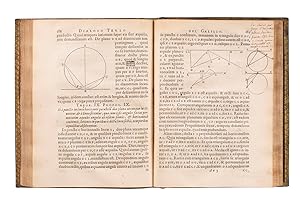
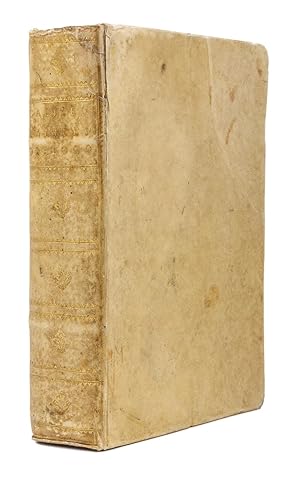
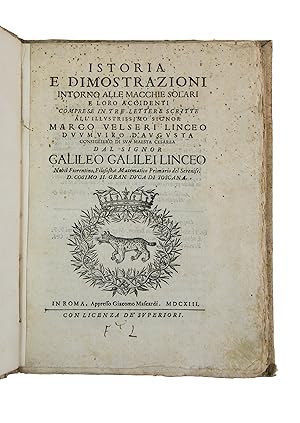
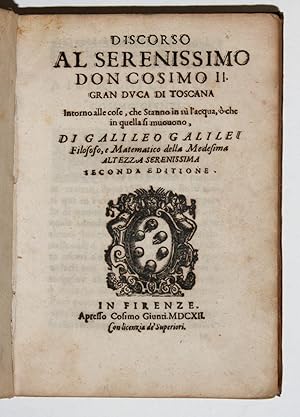
![Imagen del vendedor de [Dialogo] Systema cosmicum . in quo quatuor dialogis, de duobus maximis mundi systematibus, ptolemaico & copernicano, utriusq; rationibus philosophicis ac naturalibus indefinite propositis, disseritur . Accessit appendix gemina, qua SS. Scripturæ dicta cum terræ mobilitate conciliantur a la venta por SOPHIA RARE BOOKS](https://pictures.abebooks.com/inventory/md/md31000842426.jpg)
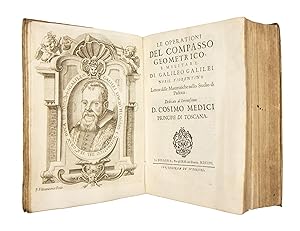
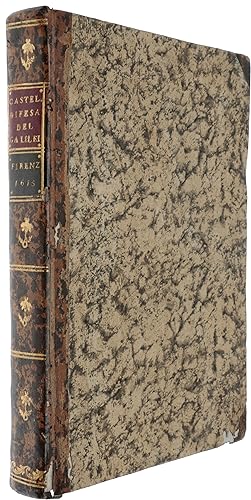
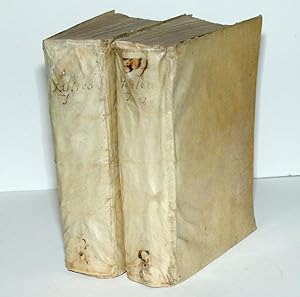
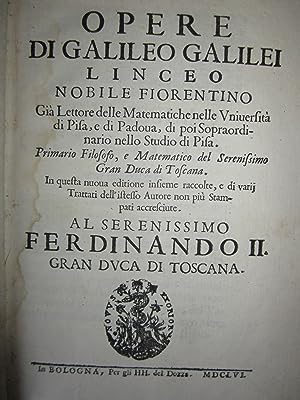
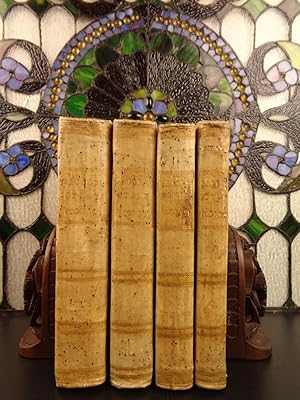
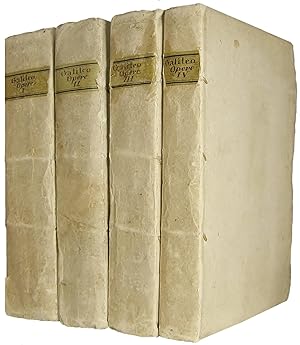
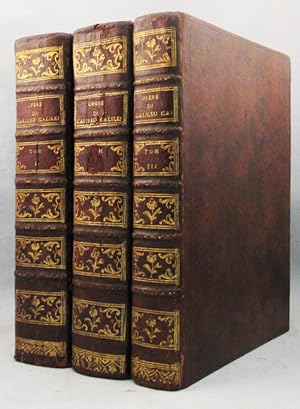

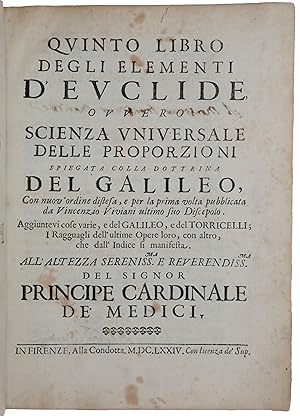
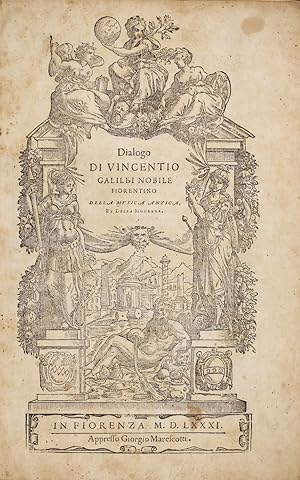
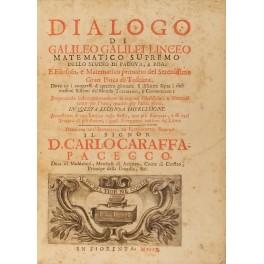
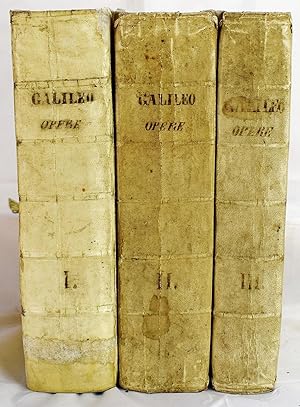
![Imagen del vendedor de Systema cosmicum. In quo dialogis IV. de duobus maximis mundi systematibus, Ptolemaico et Copernicano, rationibus utrinque propositis indefinite ac solide disseritur. Accessit altera hac editione praeter conciliationem Locorum S. Scripturae cum terrae mobilitate, ejusdem Tractatus de motu, nunc primum ex Italico sermone in Latinum versus. LugduniBatavorum [Leiden], apud Frider. Haaringet Dav. Severinum Bibliopolas 1699, Lashed to: Discursus et demonstrations mathematicae, circa duas novas scientias pertinentes ad Mechanicam et motum localem eximii viri Galilaei Galilaei [ .] Quibus accedit Appendix de centro gravitatis quorundam Solidorum. 2 works in one volume. a la venta por Antikvariat Valentinska](https://pictures.abebooks.com/inventory/md/md14448856066.jpg)
![Imagen del vendedor de Systema cosmicum in quo dialogis IV de duobus maximis mundi systematibus. Ptolemaico & Copernicano; [bound with:] Discursus et demonstrationes mathematicae circa duas novas scientias. a la venta por Moroccobound Fine Books, IOBA](https://pictures.abebooks.com/inventory/md/md22759375153.jpg)
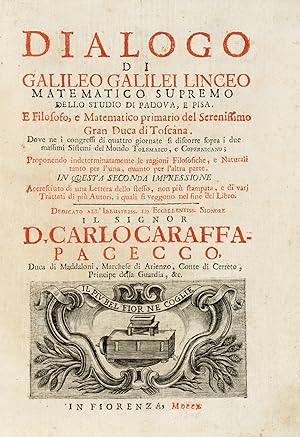
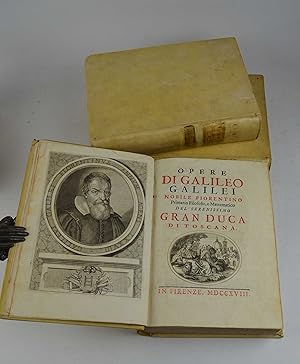
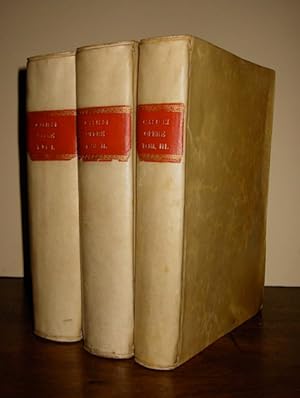
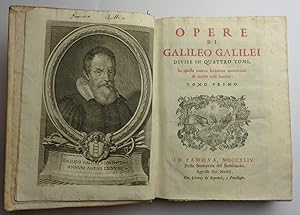
![Imagen del vendedor de OPERE DI GALILEO GALILEI NOBILE FIORENTINO [Three Volumes] a la venta por Second Story Books, ABAA](https://pictures.abebooks.com/inventory/md/md31252019981.jpg)
